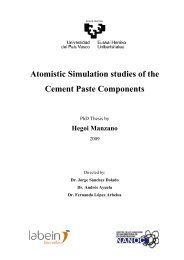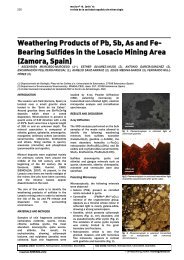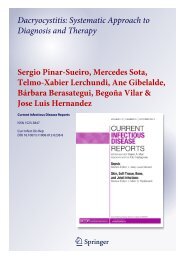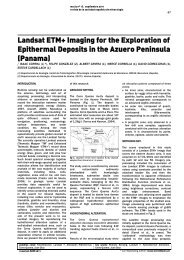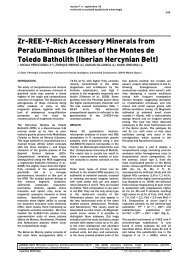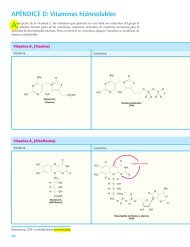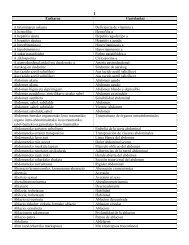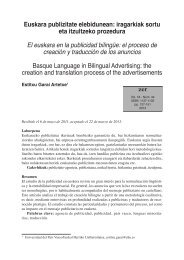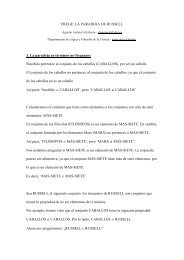Continuidad de funciones de varias variables.
Continuidad de funciones de varias variables.
Continuidad de funciones de varias variables.
Create successful ePaper yourself
Turn your PDF publications into a flip-book with our unique Google optimized e-Paper software.
2. CÁLCULO DE LÍMITES.<br />
Consi<strong>de</strong>remos una función arbitraria f : R m → R n con dominio D(f) = D.<br />
Sean S ⊂ D, −→ x0 ∈ R m , −→ y0 ∈ R n .<br />
Diremos que lím<br />
x→x0<br />
x∈S<br />
S es igual a −→ y0), cuando<br />
f(x) = y0 (en palabras, el límite <strong>de</strong> f en −→ x0 a lo largo <strong>de</strong><br />
∀ε > 0, ∃δ > 0 : f(x) ∈ B(y0, ε), ∀x ∈ (B(x0, δ) \ {x0}) ∩ S.<br />
Equivalentes a este enunciado son los siguientes:<br />
∀ε > 0, ∃δ > 0 : f (B(x0, δ) \ {x0}) ∩ S ⊂ B(y0, ε);<br />
∀ε > 0, ∃δ > 0 : 0 < x − x0 < δ, x ∈ S =⇒ f(x) − y0 < ε.<br />
Esta <strong>de</strong>finición es una simple extensión <strong>de</strong> la <strong>de</strong>finición usual <strong>de</strong> límite <strong>de</strong><br />
una función real don<strong>de</strong> se sustituye la distancia en R (dada por el valor<br />
absoluto) por la distancia en cada uno <strong>de</strong> los espacios métricos R m y R n<br />
(dada por la correspondiente norma euclí<strong>de</strong>a).<br />
Observemos que la <strong>de</strong>finición no tiene sentido si x0 ∈ S ′ pues, en este caso,<br />
(B(x0, δ)\{x0})∩S = ∅ y cualquier punto pue<strong>de</strong> ser el límite <strong>de</strong> una función<br />
en x0. En el caso <strong>de</strong> que S = D, y no haya lugar a confusión, escribiremos<br />
simplemente lím f(x).<br />
x→x0<br />
Enunciamos a continuación las siguientes propieda<strong>de</strong>s básicas <strong>de</strong>l límite.<br />
Teorema 1. Si existe lím<br />
x→x0<br />
x∈S<br />
Teorema 2. Sea T ⊂ S ⊂ D. Entonces<br />
lím<br />
x→x0<br />
x∈S<br />
(ver problemas 2.6 y 2.8).<br />
f(x), este límite es único.<br />
f(x) = y0 =⇒ lím<br />
x→x0<br />
x∈T<br />
f(x) = y0<br />
Teorema 3 (Operaciones algebraicas con el límite.) Dadas dos <strong>funciones</strong><br />
f : D1 ⊂ Rm → Rn y g : D2 ⊂ Rm → Rn , y un conjunto S ⊂ D1 ∩ D2, si<br />
lím f(x) = y1 y lím g(x) = y2, entonces:<br />
x→x0<br />
x∈S<br />
x→x0<br />
x∈S<br />
(a) lím (f + g)(x) = y1 + y2.<br />
x→x0<br />
x∈S<br />
(b) lím (λf)(x) = λy1.<br />
x→x0<br />
x∈S<br />
68





